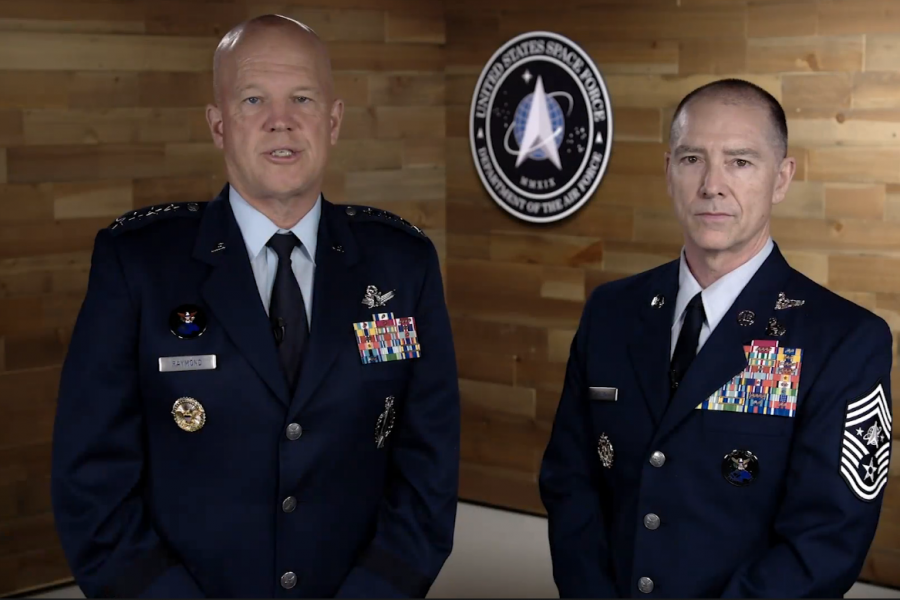The Space Force on July 24 made major organizational changes, including inactivating wings and activating new commands, while selection boards are meeting to bring in thousands of new uniformed personnel.
During a live streamed ceremony, the Space Force inactivated three space wings and eight lower echelon commands previously part of Air Force Space Command, and activated its new Space Training and Readiness Delta Provisional, two garrison commands, and eight mission deltas—the service’s term for the command level known in the Air Force as a wing.
“Today we take action, an important and significant step, towards the development of a 21st century service purpose-built to achieve speed, agility, and unity of effort,” said Gen. John W. “Jay” Raymond, Chief of Space Operations, during the ceremony. “This ceremony highlights the most significant restructure of space units since the establishment of the Air Force Space Command in 1982.”
The new Space Training and Readiness Delta Provisional is the precursor to the Space Force’s forthcoming Space Training and Readiness Command, or STARCOM, which will oversee training in the new service. STAR Delta Provisional will oversee educational, training, and operational test and evaluation units for now, according to a Space Force release. In addition to STARCOM, the Space Force will stand up Space Operations Command and Space Systems Command.
Also at the ceremony, the 21st Space Wing at Peterson Air Force Base, Colo., and the 50th Space Wing at Schriever Air Force Base, Colo., inactivated and the new Peterson-Schriever Garrison was activated. The new garrison, headquartered at Peterson, will also oversee Thule Air Base, Greenland; Cheyenne Mountain Air Force Station, Colo.; Kaena Point Air Force Station, Hawaii; and New Boston Air Force Station, N.H., along with supporting 16 more locations, according to a release.
The 460th Space Wing at Buckley Air Force Base, Colo., was also inactivated, and the new Buckley Garrison was activated. This garrison will provide support to Cape Cod Air Force Station, Mass.; Cavalier Air Force Station, N.D.; and Clear Air Force Station, Alaska, along with supporting 10 additional locations, the release stated.
Additional changes include:
- The 21st Operations Group at Peterson inactivated, replaced by Space Delta 2 (Space Domain Awareness).
- The 721st Operations Group at Peterson inactivated, replaced by Space Delta 3 (Space Electronic Warfare).
- The 460th Operations Group at Buckley inactivated, replaced by Space Delta 4 (Missile Warning).
- The 614th Air Operations Center at Vandenberg Air Force Base, Calif., inactivated, replaced by Space Delta 5 (Command and Control).
- The 50th Network Operations Group at Schriever inactivated, replaced by Space Delta 6 (Cyberspace Operations).
- Space Delta 7 (Intelligence, Surveillance, and Reconnaissance) activated, to partner with the 544th ISR Group at Peterson.
- The 50th Operations Group at Schriever inactivated, replaced by Space Delta 8 (Satellite Communications/Navigation Warfare).
- The 750th Operations Group at Schriever inactivated, replaced by Space Delta 9 (Orbital Warfare).
Additionally, four more units from the Air Force have been realigned to the Space Force: U.S. Air Force Warfare Center Detachment I, 705th Combat Training Squadron Operating Location Alpha, 25th Space Range Squadron, and the 527th Space Aggressor Squadron.
Speaking July 24 at a Center for a New American Security webinar, Raymond said Space Force selection boards are meeting to select the next 6,500 members of the service. Almost 9,000 Airmen applied for the opportunity to transfer to the new service, and 2,410 Active-duty Airmen in the space operations (13S) and space system operations (1C6) Air Force Specialty Codes were initially selected. The Airmen now facing boards are in career fields that are common to both the Air Force and Space Force, such as acquisition, engineers, and cyber.
“As a small force, we can be extremely selective and get the talent that we need,” Raymond said. “We want to build this service as the first digital service, and so that’s one of the key tenants that we’re working through,” he said. “We have defined the requirements—what the numbers are that are required in each of those career fields, and then in those areas where there are greater [numbers of] folks that have applied and we are in the process of having a board to score those records, and pick those who will come into the service.”
There are three groups of personnel in the service: Those who have already been assigned, those who will remain in the Air Force but provide support—security forces and services, for example—and this third tranche of personnel to be selected. In addition to existing cyber, acquisition, and engineering career fields, Raymond said the service plans to bring in its own dedicated software development team.
